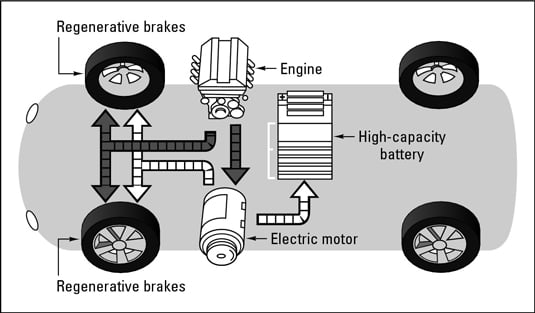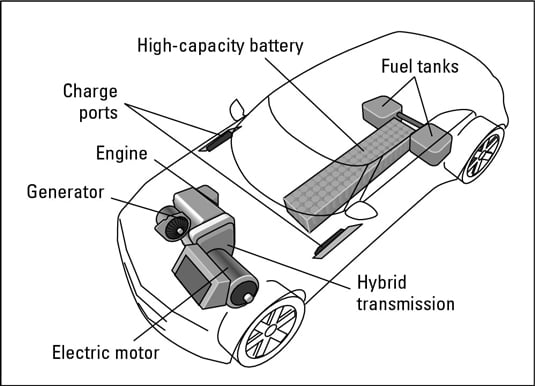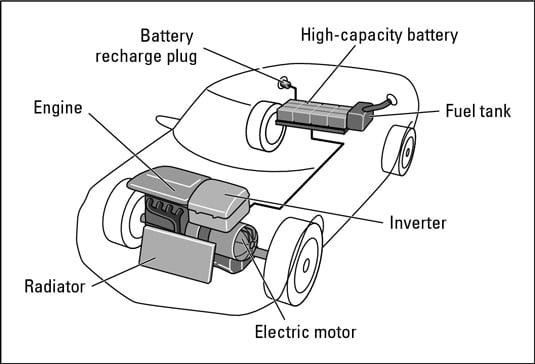All you need to know about Hybrid cars.

A hybrid car is one that uses more than one means of propulsion - that means combining a petrol or diesel engine with an electric motor.
The main advantages of a hybrid are that it should consume less fuel and emit less CO2 than comparable conventional petrol or diesel-engined vehicle.

Different Types of Hybrids and Their Working
Hybrid cars have a conventional engine, an electric motor, and a battery. There are three different types of hybrids and each works in a different way.
Parallel Hybrid

In this most common design, the electric motor(s) and gasoline engine are connected in a common transmission that blends the two power sources. That transmission can be an automatic, a manual, or a continuously variable transmission (CVT). One very popular hybrid transmission is a power-split CVT, which is used by the Toyota Prius and Chevrolet Volt. Transmission type and the size of the gasoline engine are the main factors that determine how a parallel hybrid will accelerate, sound, and feel. Brands that use the parallel design include Toyota, Lexus, Hyundai, Kia, Ford, Honda, Lincoln, Nissan, and Infiniti.
Series Hybrid

In this design, the electric motor(s) provides all the thrust, and there is never a physical mechanical connection between the engine and the wheels. The gasoline engine is just there to recharge the battery. This results in a driving experience that's more indicative of an electric car, with smoother, powerful acceleration. There's typically less vibration when the gasoline engine engages. However, that engagement doesn't always happen in concert with what your right foot is doing (remember, the battery is making the demands), so the engine might be revving up while the car is cruising at a steady speed. Some find this behavior disconcerting. The BMW i3 with the range extender is an example of a series hybrid.
Plug-In Hybrid

A plug-in hybrid enhances the conventional hybrid concept with a much larger battery pack that, like an electric car's, must be fully recharged using an external electricity source—from your home, office, or public charging station. This greater amount of energy storage is like a larger gas tank: It allows for extended all-electric driving (between 15 and 55 miles depending on the model) and can significantly reduce fuel consumption. In fact, if you have a short commute and recharge nightly, you'll be running on electricity most of the time. Should you deplete the all-electric range, the car basically reverts to being a conventional parallel hybrid.
What are the benefits of a hybrid car?
Hybrid car owners also get extra benefits in the shape of lower first year road tax and company car tax, as well as possibly avoiding congestion charges.

Different Types of Hybrids and Their Working
Hybrid cars have a conventional engine, an electric motor, and a battery. There are three different types of hybrids and each works in a different way.

In this most common design, the electric motor(s) and gasoline engine are connected in a common transmission that blends the two power sources. That transmission can be an automatic, a manual, or a continuously variable transmission (CVT). One very popular hybrid transmission is a power-split CVT, which is used by the Toyota Prius and Chevrolet Volt. Transmission type and the size of the gasoline engine are the main factors that determine how a parallel hybrid will accelerate, sound, and feel. Brands that use the parallel design include Toyota, Lexus, Hyundai, Kia, Ford, Honda, Lincoln, Nissan, and Infiniti.
Series Hybrid

In this design, the electric motor(s) provides all the thrust, and there is never a physical mechanical connection between the engine and the wheels. The gasoline engine is just there to recharge the battery. This results in a driving experience that's more indicative of an electric car, with smoother, powerful acceleration. There's typically less vibration when the gasoline engine engages. However, that engagement doesn't always happen in concert with what your right foot is doing (remember, the battery is making the demands), so the engine might be revving up while the car is cruising at a steady speed. Some find this behavior disconcerting. The BMW i3 with the range extender is an example of a series hybrid.
Plug-In Hybrid

A plug-in hybrid enhances the conventional hybrid concept with a much larger battery pack that, like an electric car's, must be fully recharged using an external electricity source—from your home, office, or public charging station. This greater amount of energy storage is like a larger gas tank: It allows for extended all-electric driving (between 15 and 55 miles depending on the model) and can significantly reduce fuel consumption. In fact, if you have a short commute and recharge nightly, you'll be running on electricity most of the time. Should you deplete the all-electric range, the car basically reverts to being a conventional parallel hybrid.
Driving a hybrid is similar to driving a conventional automatic car, so there’s little compromise on performance.
Most strong hybrids will have a choice of power modes, too, ranging from eco to power, enabling the driver to choose maximum efficiency or performance depending on the driving conditions.
Range anxiety isn’t an issue and you don’t need to a charging point because hybrids charge up their own batteries.
Although the tax benefits of hybrid ownership aren’t as big as they used to be, company car drivers still pay less Benefit-In-Kind (BIK) tax than drivers of petrol or diesel cars, and cars emitting less than 75g/km qualify for London congestion charge exemption.
Should I buy a hybrid car?
Most strong hybrids will have a choice of power modes, too, ranging from eco to power, enabling the driver to choose maximum efficiency or performance depending on the driving conditions.
Range anxiety isn’t an issue and you don’t need to a charging point because hybrids charge up their own batteries.
Although the tax benefits of hybrid ownership aren’t as big as they used to be, company car drivers still pay less Benefit-In-Kind (BIK) tax than drivers of petrol or diesel cars, and cars emitting less than 75g/km qualify for London congestion charge exemption.
Should I buy a hybrid car?
A hybrid car will suit you if you do most of your mileage in and around town because you’ll gain the most benefit from running on electric only power, which is effectively free travel.
If you do frequent short trips and don’t need the extra flexibility of a hybrid, then you may be better off with an electric car, which will give you cheap urban travel and no tailpipe emissions.
However, if you do a lot of motorway miles you may be better off with an efficient diesel car. It’s likely to provide better high-speed fuel economy than a hybrid because motorways and fast A-roads are the types of road on which hybrids are least efficient.
If you do frequent short trips and don’t need the extra flexibility of a hybrid, then you may be better off with an electric car, which will give you cheap urban travel and no tailpipe emissions.
However, if you do a lot of motorway miles you may be better off with an efficient diesel car. It’s likely to provide better high-speed fuel economy than a hybrid because motorways and fast A-roads are the types of road on which hybrids are least efficient.